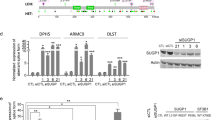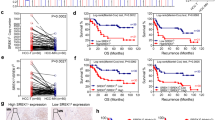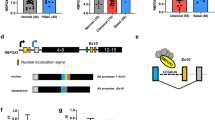Abstract
We report a new mechanism of aberrant pre-mRNA splicing resulting in constitutive activation of a mis-spliced oncoprotein (KIT) leading to malignancy (gastrointestinal stromal tumor) in contrast to loss of function of mis-spliced proteins resulting in diverse human diseases in the literature. The mechanisms of three consecutive molecular events, deletion of noncoding and coding regions encompassing the 3′ authentic splice site, creation of a novel intra-exonic pre-mRNA 3′ splice acceptor site leading to in-frame loss of 27 nucleotides (nine amino acids; Lys550–Lys558), and the mechanism of constitutive activation of the mis-spliced KIT are elucidated. Loss of a peptide in a critical location unleashed the protein from autoinhibition (as evidenced by three-dimensional structural analysis), causing KIT to become constitutively activated and resulting in the GIST phenotype. We also demonstrated that only one of the following two exonic splicing enhancers is sufficient for inclusion of the KIT exon 11 in vivo: AACCCATGT (nucleotides 2–10 from the 5′ end, which are recognized by SC35, SRp55, and SF2/ASF) or GGTTGTTGAGG (nucleotides 27–37 from the 5′ end, which are recognized by SC35 and SRp55), suggestive of exonic enhancer redundancy.
This is a preview of subscription content, access via your institution
Access options
Subscribe to this journal
Receive 50 print issues and online access
$259.00 per year
only $5.18 per issue
Buy this article
- Purchase on Springer Link
- Instant access to full article PDF
Prices may be subject to local taxes which are calculated during checkout






Similar content being viewed by others
References
Allander SV, Nupponen NN, Ringner M, Hostetter G, Maher GW, Goldberger N, Chen Y, Carpten J, Elkahloun AG and Meltzer PS . (2001). Cancer Res., 61, 8624–8628.
Aznarez I, Chan EM, Zielenski J, Blencowe BJ and Tsui LC . (2003). Hum. Mol. Genet., 12, 2031–2040.
Black DL . (2003). Annu. Rev. Biochem., 72, 291–336.
Buratti E, Baralle FE and Pagani F . (2003). Trends Mol. Med., 9, 229–232.
Cartegni L, Chew SL and Krainer AR . (2002). Nat. Rev. Genet., 3, 285–298.
Cartegni L, Wang J, Zhu Z, Zhang MQ and Krainer AR . (2003). Nucleic Acids Res., 31, 3568–3571.
Chan PM, Ilangumaran S, La Rose J, Chakrabartty A and Rottapel R . (2003). Mol. Cell Biol., 23, 3067–3078.
Chen LL, Trent JC, Wu EF, Fuller GN, Ramdas L, Zhang W, Raymond AK, Prieto VG, Oyedeji CO, Hunt KK, Pollock RE, Feig BW, Hayes KJ, Choi H, Macapinlac HA, Hittelman W, Velasco MA, Patel S, Burgess MA, Benjamin RS and Frazier ML . (2004). Cancer Res., 64, 5913–5919.
Colapietro P, Gervasini C, Natacci F, Rossi L, Riva P and Larizza L . (2003). Hum. Genet., 113, 551–554.
Corless CL, McGreevey L, Town A, Schroeder A, Bainbridge T, Harrell P, Fletcher JA and Heinrich MC . (2004). J. Molec. Diagn., 6, 366–370.
Crosier PS, Ricciardi ST, Hall LR, Vitas MR, Clark SC and Crosier KE . (1993). Blood, 82, 1151–1158.
Di Blasi C, He Y, Morandi L, Cornelio F, Guicheney P and Mora M . (2001). Brain, 124, 698–704.
Goldstrohm A, Greenleaf A and Garcia-Blanco M . (2001). Gene, 277, 31–47.
Gorlov IP, Gorlova OY, Frazier ML and Amos CI . (2003). Am. J. Hum. Genet., 73, 1157–1161.
Graveley B . (2002). Cell, 109, 409–412.
Guex N and Peitsch MC . (1997). Electrophoresis, 18, 2714–2723.
Hammes A, Guo JK, Lutsch G, Leheste JR, Landrock D, Ziegler U, Gubler MC and Schedl A . (2001). Cell, 106, 319–329.
Harland M, Mistry S and Bishop DT . (2001). Hum. Mol. Genet., 10, 2679–2686.
Heinrich MC, Corless CL, Demetri GD, Blanke CD, von Mehren M, Joensuu H, McGreevey LS, Chen CJ, van den Abbeele AD, Druker BJ, Kiese B, Eisenberg B, Roberts PJ, Singer S, Fletcher CD, Silberman S, Dimitrijevic S and Fletcher JA . (2003a). J. Clin. Oncol., 21, 4342–4349.
Heinrich MC, Corless CL, Duensing A, McGreevey L, Chen CJ, Joseph N, Singer S, Griffith DJ, Haley A, Town A, Demetri GD, Fletcher CD and Fletcher JA . (2003b). Science, 299, 708–710.
Hirota S, Isozaki K, Moriyama Y, Hashimoto K, Nishida T, Ishiguro S, Kawano K, Hanada M, Kurata A, Takeda M, Muhammad Tunio G, Matsuzawa Y, Kanakura Y, Shinomura Y and Kitamura Y . (1998). Science, 279, 577–580.
Hirota S, Ohashi A, Nishida T, Isozaki K, Kinoshita K, Shinomura Y and Kitamura Y . (2003). Gastroenterology, 125, 660–667.
Isozaki K, Terris B, Belghiti J, Schiffmann S, Hirota S and Vanderwinden JM . (2000). Am. J. Pathol., 157, 1581–1585.
Jurica MS and Moore MJ . (2003). Mol. Cell, 12, 5–14.
Kinoshita K, Isozaki K, Hirota S, Nishida T, Chen H, Nakahara M, Nagasawa Y, Ohashi A, Shinomura Y, Kitamura Y and Matsuzawa Y . (2003). J. Gastroenterol. Hepatol., 18, 147–151.
Koh JS, Trent J, Chen L, El-Naggar A, Hunt K, Pollock R and Zhang W . (2004). Histol. Histopathol., 19, 565–574.
Ladd AN . (2002). Genome Biol., 3, reviews 0008.1–0008.16.
Liu HX, Cartegni L, Zhang MQ and Krainer AR . (2001). Nat. Genet., 27, 55–58.
Ma Y, Cunningham ME, Wang X, Ghosh I, Regan L and Longley BJ . (1999). J. Biol. Chem., 274, 13399–13402.
Modrek B and Lee C . (2002). Nat. Genet., 30, 13–19.
Mol CD, Dougan DR, Schneider TR, Skene RJ, Kraus ML, Scheibe DN, Snell GP, Zou H, Sang BC and Wilson KP . (2004). J. Biol. Chem., 279, 31655–31663.
Namour F, Helfer AC, Quadros EV, Alberto JM, Bibi HM, Orning L, Rosenblatt DS and Jean-Louis G . (2003). Br. J. Haematol., 123, 915–920.
Nelson KK and Green MR . (1990). Proc. Natl. Acad. Sci. USA, 87, 6253–6257.
Pagani F, Buratti E, Stuani C, Bendix R, Dork T and Baralle FE . (2002). Nat. Genet., 30, 426–429.
Pagani F and Baralle FE . (2004). Nat. Rev. Genet., 5, 389–396.
Roca X, Sachidanandam R and Krainer AR . (2003). Nucleic Acids Res., 31, 6321–6333.
Sandberg AA and Bridge JA . (2002). Cancer Genet. Cytogenet., 135, 1–22.
Smith C and Valcarcel J . (2000). Trends Biochem. Sci., 25, 381–388.
Sommer G, Agosti V, Ehlers I, Rossi F, Corbacioglu S, Farkas J, Moore M, Manova K, Antonescu CR and Besmer P . (2003). Proc. Natl. Acad. Sci. USA, 100, 6706–6711.
Syrris P, Heathcote K, Carrozzo R, Devriendt K, Elcioglu N, Garrett C, McEntagart M and Carter ND . (2002). Hum. Mutat., 20, 234–237.
Taniguchi M, Nishida T, Hirota S, Isozaki K, Ito T, Nomura T, Matsuda H and Kitamura Y . (1999). Cancer Re., 59, 4297–4300.
Wagner EJ and Garcia-Blanco MA . (2001). Mol. Cell Biol., 21, 3281–3288.
Zhu WM, Dong WF and Minden M . (1994). Leuk. Lymphoma, 12, 441–447.
Acknowledgements
We thank WK Hong and RS Benjamin for divisional and departmental support, HL Evans for assistance in pathology, LJ Corley, P Zhang, and MA Velasco for laboratory assistance, LA Gratten for manuscript preparation, and TA Simmons for clinical data preparation. MS was supported in part by cancer prevention fellowships funded by National Cancer Institute Grant R25 CA57730 (principal investigator RM Chamberlain). This work was supported by funds from an Institutional Research Grant from the University of Texas MD Anderson Cancer Center, National Cancer Institute grants CA16672 (supporting the DNA sequencing core facility, nucleic acid core facility, and tissue procurement and banking facility), U01-CA70172-01, N0-CM-17003, and the Goodwin Foundation.
Author information
Authors and Affiliations
Corresponding author
Additional information
Competing interest statement
The authors declare that they have no competing financial interests.
Rights and permissions
About this article
Cite this article
Chen, L., Sabripour, M., Wu, E. et al. A mutation-created novel intra-exonic pre-mRNA splice site causes constitutive activation of KIT in human gastrointestinal stromal tumors. Oncogene 24, 4271–4280 (2005). https://doi.org/10.1038/sj.onc.1208587
Received:
Revised:
Accepted:
Published:
Issue Date:
DOI: https://doi.org/10.1038/sj.onc.1208587
Keywords
This article is cited by
-
A novel splice site indel alteration in the EIF2AK3 gene is responsible for the first cases of Wolcott-Rallison syndrome in Hungary
BMC Medical Genetics (2020)
-
Splice variants of RAS—translational significance
Cancer and Metastasis Reviews (2020)
-
Alternative tumour-specific antigens
Nature Reviews Cancer (2019)
-
Splice variants of zinc finger protein 695 mRNA associated to ovarian cancer
Journal of Ovarian Research (2013)
-
A comprehensive analysis of prognostic signatures reveals the high predictive capacity of the Proliferation, Immune response and RNA splicing modules in breast cancer
Breast Cancer Research (2008)



